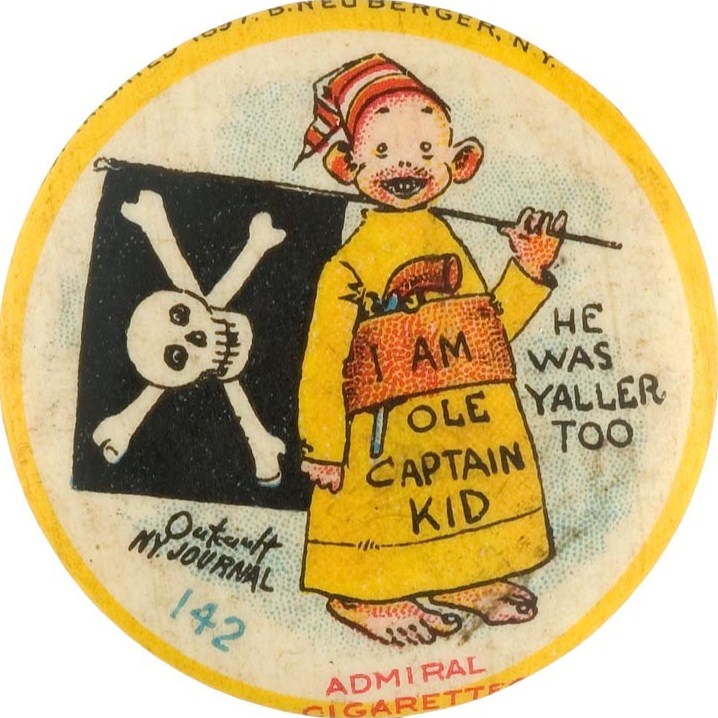Cartoonist Richard Felton Outcault started drawing funny pictures about New York tenements in 1894, for Truth magazine. The first appeared in that year's June 2 edition. On Feb. 17, 1895, one of them was reprinted in Joseph Pulitzer's newspaper, The New York World, inaugurating the series from which The Yellow Kid would eventually emerge. By the end of that year, Outcault was doing full-page ones, in color, on a weekly basis, under the title Hogan's Alley (which appeared on a street sign as early as the very first of the Truth magazine cartoons). Gradually, there emerged a distinctive young character, identifiable by a bald head, huge ears, and a bright yellow nightshirt, which later had his dialog written on it. He wasn't usually addressed by any particular name (although when that did happen, the name was was Mickey Dugan), but readers came to know him as The Yellow Kid.
In 1896, William Randolph Hearst, Pulitzer's arch-rival for newspaper readership, raided Pulitzer's cartooning staff, and Outcault was lured away by Hearst's money. He continued the feature for Hearst, prompting Pulitzer to sue. The judge took his cue from Solomon and divided the baby, ruling that Outcault could take the character wherever he liked, but the name Hogan's Alley belonged to Pulitzer. George Luks continued the feature at the World, while Outcault began drawing it under a new name, McFadden's Row of Flats, for Hearst's New York Journal.
With that opening shot, the Hearst/Pulitzer circulation war was on. Its fallout included the entire American comics industry.
Eventually, they all gave in to the inevitable, and simply called both features The Yellow Kid (tho the Hogan's Alley title was still closely enough associated with it to have been used in the title of a 1903 film short based on the series). It was heavily merchandised in the New York area under that name, with products like gum, postcards, baby clothes, and even household appliances, until February 6, 1898, when Outcault returned to Pulitzer. He did a number of other comics features over the next few years, including Kelly's Kindergarten, Pore Lil Mose and The Barnyard Club, and is possibly best known for a feature he started for The New York Herald in 1902 — Buster Brown, which was even more heavily merchandised.
The Yellow Kid made regular guest appearances on Buster's page, but was never again the star of his own series. But by that time, both Hearst and Pulitzer were running a vast array of comics in all their papers, coast to coast, and it was getting so a newspaper could scarcely survive without a good selection of comics.
In 1995, as good a year as any in that range for celebrating the hundredth anniversary of Hogan's Alley, the U.S. Postal Service issued its "Comic Strip Classics" series of stamps. Needless to say, The Yellow Kid was the first of them. The series also included Little Nemo in Slumberland, Brenda Starr, Bringing Up Father, Alley Oop, Prince Valiant, and several others.
Incidentally, comics have given our language quite a few expressions, including "Gloomy Gus" (from Happy Hooligan), "Dagwood sandwich" (from Blondie) and "druthers" (from Li'l Abner). The very first came from this feature. The papers that ran it were often referred to by New Yorkers as the "Yellow Kid" papers or, simply, "the yellow papers". During the Spanish American War (1898), when their sensational and unreliable reportage reached a fever pitch, that style came to be known as "yellow journalism".
See http://www.toonopedia.com/yellow.htm
Also cf: http://cartoons.osu.edu/yellowkid/index.htm

No comments:
Post a Comment